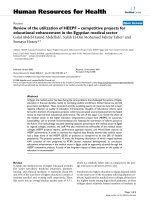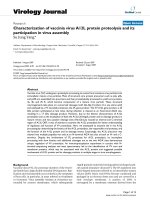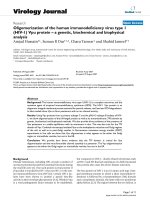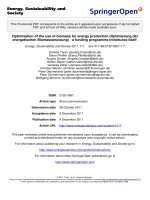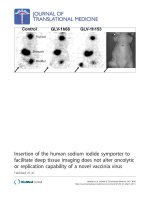Báo cáo sinh học: " Convergence of the modified Mann''''s iterative method for asymptotically kappa-strictly pseudocontractive mappings" pptx
Bạn đang xem bản rút gọn của tài liệu. Xem và tải ngay bản đầy đủ của tài liệu tại đây (219.66 KB, 14 trang )
This Provisional PDF corresponds to the article as it appeared upon acceptance. Fully formatted
PDF and full text (HTML) versions will be made available soon.
Convergence of the modified Mann's iterative method for asymptotically
kappa-strictly pseudocontractive mappings
Fixed Point Theory and Applications 2011, 2011:100 doi:10.1186/1687-1812-2011-100
Ying Zhang ()
Zhiwei Xie ()
ISSN 1687-1812
Article type Research
Submission date 4 May 2011
Acceptance date 9 December 2011
Publication date 9 December 2011
Article URL />This peer-reviewed article was published immediately upon acceptance. It can be downloaded,
printed and distributed freely for any purposes (see copyright notice below).
For information about publishing your research in Fixed Point Theory and Applications go to
/>For information about other SpringerOpen publications go to
Fixed Point Theory and
Applications
© 2011 Zhang and Xie ; licensee Springer.
This is an open access article distributed under the terms of the Creative Commons Attribution License ( />which permits unrestricted use, distribution, and reproduction in any medium, provided the original work is properly cited.
Convergence of the modified Mann’s iterative
method for asymptotically κ-strictly
pseudocontractive mappings
Ying Zhang
∗,1,2
and Zhiwei Xie
3
1
School of Mathematics and Physics,
North China Electric Power University, Baoding, Hebei 071003, P.R. China
2
School of Economics, Renmin University of China,
Beijing 100872, P.R. China
3
Easyway Company Limited, Beijing 100872, P.R. China
*Corresponding author:
Email address:
ZX:
Abstract
Let E be a real uniformly convex Banach space which has the Fr´echet differentiable
norm, and K a nonempty, closed, and convex subset of E. Let T : K → K b e an asymp-
totically κ-strictly pseudocontractive mapping with a nonempty fixed point set. We prove
that (I − T ) is demiclosed at 0 and obtain a weak convergence theorem of the modi-
fied Mann’s algorithm for T under suitable control conditions. Moreover, we also elicit
a necessary and sufficient condition that guarantees strong convergence of the modified
Mann’s iterative sequence to a fixed point of T in a real Banach spaces with the Fr´echet
differentiable norm.
2000 AMS Subject Classification: 47H09; 47H10.
Keywords: asymptotically κ-strictly pseudocontractive mappings; demiclosedness prin-
ciple; the modified Mann’s algorithm; fixed points.
1 Introduction
Let E and E
∗
be a real Banach space and the dual space of E, respectively. Let K be a
nonempty subset of E. Let J denote the normalized duality mapping from E into 2
E
∗
given
by J(x) = {f ∈ E
∗
: x, f = x
2
= f
2
}, for all x ∈ E, where ·, · denotes the duality
1
pairing between E and E
∗
. In the sequel, we will denote the set of fixed points of a mapping
T : K → K by F (T ) = {x ∈ K : Tx = x}.
A mapping T : K → K is called asymptotically κ-strictly pseudocontractive with sequence
{κ
n
}
∞
n=1
⊆ [1, ∞) such that lim
n→∞
κ
n
= 1 (see, e.g., [1–3]) if for all x, y ∈ K, there exist a
constant κ ∈ [0, 1) and j(x − y) ∈ J(x − y) such that
T
n
x − T
n
y, j(x − y) ≤ κ
n
x − y
2
− κx − y − (T
n
x − T
n
y)
2
, ∀n ≥ 1. (1)
If I denotes the identity operator, then (1) can be written as
(I −T
n
)x−(I −T
n
)y, j(x−y) ≥ κ(I −T
n
)x−(I −T
n
)y
2
−(κ
n
−1)x−y
2
, ∀n ≥ 1. (2)
The class of asymptotically κ-strictly pseudo contractive mappings was first introduced in
Hilbert spaces by Qihou [3]. In Hilbert spaces, j is the identity and it is shown by Osilike
et al. [2] that (1) (and hence (2)) is equivalent to the inequality
T
n
x − T
n
y
2
≤ λ
n
x − y
2
+ λx − y − (T
n
x − T
n
y)
2
,
where lim
n→∞
λ
n
= lim
n→∞
[1 + 2(κ
n
− 1)] = 1, λ = (1 − 2κ) ∈ [0, 1).
A mapping T with domain D(T) and range R(T ) in E is called strictly pseudocontractive of
Browder–Petryshyn type [4], if for all x, y ∈ D(T ), there exists κ ∈ [0, 1) and j(x−y) ∈ J(x − y)
such that
T x − Ty, j(x − y) ≤ x − y
2
− κx − y − (Tx − T y)
2
. (3)
If I denotes the identity operator, then (3) can be written as
(I − T )x − (I − T )y, j(x − y) ≥ κ(I − T)x − (I − T )y
2
. (4)
In Hilbert spaces, (3) (and hence (4)) is equivalent to the inequality
T x − Ty
2
≤ x − y
2
+ kx − y − (T x − Ty)
2
, k = (1 − 2κ) < 1,
It is shown in [5] that the class of asymptotically κ-strictly pseudocontractive mappings and
the class of κ-strictly pseudocontractive mappings are independent.
A mapping T is said to be uniformly L-Lipschitzian if there exists a constant L > 0 such
that
T
n
x − T
n
y ≤ Lx − y, n ≥ 1
for all x, y ∈ K and is said to be demiclosed at a point p if whenever {x
n
} ⊂ D(T) such that
{x
n
} converges weakly to x ∈ D(T ) and {T x
n
} converges strongly to p, then Tx = p.
Kim and Xu [6] studied weak and strong convergence theorems for the class of asymptotically
κ-strictly pseudocontractive mappings in Hilbert space. They obtained a weak convergence
theorem of modified Mann iterative processes for this class of mappings. Moreover, a strong
convergence theorem was also established in a real Hilbert space by hybrid projection method.
They proved the following.
Theorem KX [6] Let K be a closed and convex subset of a Hilbert space H. Let T : K → K
be an asymptotically κ-strictly pseudocontractive mapping for some 0 ≤ κ < 1 with sequence
{κ
n
} ⊂ [1, ∞) such that
∞
n=1
(κ
n
−1) < ∞ and F (T ) = ∅. Let {x
n
}
∞
n=1
be a sequence generated
by the modified Mann’s iteration method:
x
n+1
= α
n
x
n
+ (1 − α
n
)T
n
x
n
, n ≥ 1,
Assume that the control sequence {α
n
}
∞
n=1
is chosen in such a way that κ + λ ≤ α
n
≤ 1 − λ
for all n, where λ ∈ (0, 1) is a small enough constant. Then, {x
n
} converges weakly to a fixed
point of T.
The modified Mann’s iteration scheme was introduced by Schu [7, 8] and has been used by
several authors (see, for example, [1–3, 9–11]). One question is raised naturally: is the result
in Theorem KX true in the framework of the much general Banach space?
Osilike et al. [5] proved the convergence theorems of modified Mann iteration method in
the framework of q-uniformly smooth Banach spaces which are also uniformly convex. They
also obtained that a modified Mann iterative process {x
n
} converges weakly to a fixed point
of T under suitable control conditions. However, the control sequence {α
n
} ⊂ [0, 1] depended
on the Lipschizian constant L and excluded the natural choice α
n
=
1
n
, n ≥ 1. These are
motivations for us to improve the results. We prove the demiclosedness principle and weak
convergence theorem of the modified Mann’s algorithm for T in the framework of uniformly
convex Banach spaces which have the Fr´echet differentiable norm. Moreover, we also elicit a
necessary and sufficient condition that guarantees strong convergence of the modified Mann’s
iterative sequence to a fixed point of T in a real Banach spaces with the Fr ´echet differentiable
norm.
We will use the notation:
1. for weak convergence.
2. ω
W
(x
n
) = {x : ∃x
n
j
x} denotes the weak ω-limit set of {x
n
}.
2 Preliminaries
Let E be a real Banach space. The space E is called uniformly convex if for each > 0,
there exists a δ > 0 such that for x, y ∈ E with x ≤ 1, y ≤ 1, x − y ≥ , we have
1
2
(x + y) ≤ 1 − δ. The modulus of convexity of E is defined by
δ
E
() = inf{1 −
1
2
(x + y) : x ≤ 1, y ≤ 1, x − y ≥ , } ∀x, y ∈ E
for all ∈ [0, 2]. E is uniformly convex if δ
E
(0) = 0 and δ
E
() > 0 for all ∈ (0, 2]. The modulus
of smoothness of E is the function ρ
E
: [0, ∞) → [0, ∞) defined by
ρ
E
(τ) = sup{
1
2
(x + y + x − y) − 1 : x ≤ 1, y ≤ τ }, ∀x, y ∈ E.
E is uniformly smooth if and only if lim
τ→0
ρ
E
(τ)
τ
= 0.
E is said to have a Fr´echet differentiable norm if for all x ∈ U = {x ∈ E : x = 1}
lim
t→0
x + ty − x
t
exists and is attained uniformly in y ∈ U. In this case, there exists an increasing function
b : [0, ∞) → [0, ∞) with lim
t→0
[b(t)/t] = 0 such that for all x, h ∈ E
1
2
x
2
+ h, j(x) ≤
1
2
x + h
2
≤
1
2
x
2
+ h, j(x) + b(h). (5)
It is well known (see, for example, [12, p. 107]) that uniformly smooth Banach space has a
Fr´echet differentiable norm.
Lemma 2.1 [2, p. 80] Let {a
n
}
∞
n=1
, {b
n
}
∞
n=1
, {δ
n
}
∞
n=1
be nonnegative sequences of real
numbers satisfying the following inequality
a
n+1
≤ (1 + δ
n
)a
n
+ b
n
, ∀n ≥ 1.
If
∞
n=1
δ
n
< ∞ and
∞
n=1
b
n
< ∞, then lim
n→∞
a
n
exists. If in addition {a
n
}
∞
n=1
has a
subsequence which converges strongly to zero, then lim
n→∞
a
n
= 0.
Lemma 2.2 [2, p. 78] Let E be a real Banach space, K a nonempty subset of E, and
T : K → K an asymptotically κ-strictly pseudocontractive mapping. Then, T is uniformly
L-Lipschitzian.
Lemma 2.3 [13, p. 29] Let K be a nonempty, closed, convex, and bounded subset of a
uniformly convex Banach space E, and let T : K → E be a nonexpansive mappings. Let {x
n
}
be a sequence in K such that {x
n
} converges weakly to some point x ∈ K. Then, there exists
an increasing continuous function h : [0, ∞) → [0, ∞) with h(0) = 0 depending on the diameter
of K such that
h(x − T x) ≤ lim inf
n→∞
x
n
− T x
n
.
Lemma 2.4 [14, p. 9] Let E be a real Banach space with the Fr´echet differentiable norm.
For x ∈ E, let β
∗
(t) be defined for 0 < t < ∞ by
β
∗
(t) = sup
y∈U
x + ty
2
− x
2
t
− 2y, j(x)
.
Then, lim
t→0
+
β
∗
(t) = 0 and
x + h
2
≤ x
2
+ 2h, j(x) + hβ
∗
(h), ∀h ∈ E \ {0}. (6)
Remark 2.5 In a real Hilbert space, we can see that β
∗
(t) = t for t > 0. In our more general
setting, throughout this article we will still assume that
β
∗
(t) ≤ 2t,
where β
∗
is a function appearing in (6).
Then, we prove the demiclosedness principle of T in the uniformly convex Banach space
which has the Fr´echet differentiable norm.
Lemma 2 .6 Let E be a real uniformly convex Banach space which has the Fr´echet differ-
entiable norm. Let K be a nonempty, closed, and convex subset of E and T : K → K an
asymptotically κ-strictly pseudo contractive mapping with F (T) = ∅. Then, (I − T ) is demi-
closed at 0.
Proof. Let {x
n
} be a sequence in K which converges weakly to p ∈ K and {x
n
− T x
n
}
converges strongly to 0. We prove that (I − T )(p) = 0. Let x
∗
∈ F (T ). Then, there exists a
constant r > 0 such that x
n
− x
∗
≤ r, ∀n ≥ 1. Let
¯
B
r
= {x ∈ E : x − x
∗
≤ r}, and let
C = K ∩
¯
B
r
. Then, C is nonempty, closed, convex, and bounded, and {x
n
} ⊆ C. Choose any
α ∈ (0, κ) and let T
α,n
: K → K be defined for all x ∈ K by
T
α,n
x = (1 − α)x + αT
n
x, n ≥ 1,
Then for all x, y ∈ K,
T
α,n
x − T
α,n
y
2
= (x − y) − α[(I − T
n
)x − (I − T
n
)y]
2
≤ x − y
2
− 2α(I − T
n
)x − (I − T
n
)y, j(x − y)
+αx − y − (T
n
x − T
n
y)β
∗
[αx − y − (T
n
x − T
n
y)] (7)
≤ x − y
2
− 2α[κx − y − (T
n
x − T
n
y)
2
− (κ
n
− 1)x − y
2
]
+2α
2
x − y − (T
n
x − T
n
y)
2
= [1 + 2α(κ
n
− 1)]x − y
2
− 2α(κ − α)x − y − (T
n
x − T
n
y)
2
≤ τ
2
n
x − y
2
,
where τ
n
= [1+2α(κ
n
−1)]
1
2
. (In fact, in (7) the domain of β
∗
(·) requires x−y−(T
n
x−T
n
y) =
0. But when x−y −(T
n
x−T
n
y) = 0, we have T
α,n
x−T
α,n
y
2
= x−y
2
, which still satisfies
the inequality T
α,n
x − T
α,n
y
2
≤ τ
2
n
x − y
2
. So we do not specially emphasize the situation
that the argument of β
∗
(·) equals 0 in this inequality and the following proof of Theorem 3.1.)
Define G
α,m
: K → E by
G
α,m
x =
1
τ
m
T
α,m
x, m ≥ 1.
Then, G
α,m
is nonexpansive and it follows from Lemma 2.3 that there exists an increasing
continuous function h : [0, ∞) → [0, ∞) with h(0) = 0 depending on the diameter of K such
that
h(p − G
α,m
p) ≤ lim inf
n→∞
x
n
− G
α,m
x
n
. (8)
Observe that
x
n
− G
α,m
x
n
= x
n
−
1
τ
m
T
α,m
x
n
≤ x
n
− T
α,m
x
n
+ (1 −
1
τ
m
)(τ
m
x
n
− x
∗
+ x
∗
)
≤ x
n
− T
α,m
x
n
+ (1 −
1
τ
m
)(τ
m
r + x
∗
), (9)
and as n → ∞
x
n
−T
α,m
x
n
= αx
n
−T
m
x
n
≤
m
j=1
T
j−1
x
n
−T
j
x
n
≤ [1 + L(m − 1)]x
n
−T x
n
→ 0. (10)
Thus, it follows from (9) and (10) that
lim sup
n→∞
x
n
− G
α,m
x
n
≤ (1 −
1
τ
m
)(τ
m
r + x
∗
),
so that (8) implies that
h(p − G
α,m
p) ≤ (1 −
1
τ
m
)(τ
m
r + x
∗
).
Observe that
p − G
α,m
p ≥ p − T
α,m
p − (1 −
1
τ
m
)T
α,m
p
≥ p − T
α,m
p − (1 −
1
τ
m
)(τ
m
r + x
∗
),
so that
p − T
α,m
p ≤ p − G
α,m
p + (1 −
1
τ
m
)(τ
m
r + x
∗
)
≤ h
−1
[(1 −
1
τ
m
)(τ
m
r + x
∗
)] + (1 −
1
τ
m
)(τ
m
r + x
∗
) → 0, as m → ∞.
Since T is continuous, we have (I − T )(p) = 0, completing the proof of Lemma 2.6.
Lemma 2 .7 Let E be a real uniformly convex Banach space which has the Fr´echet differ-
entiable norm, and let K be a nonempty, closed, and convex subset of E. Let T : K → K be
an asymptotically κ-strictly pseudocontractive mapping with F (T ) = ∅. Let {x
n
}
∞
n=1
be the
sequence satisfying the following conditions:
(a) lim
n→∞
x
n
− p exists for every p ∈ F(T );
(b) lim
n→∞
x
n
− T x
n
= 0;
(c) lim
n→∞
tx
n
+ (1 − t)p
1
− p
2
exists for all t ∈ [0, 1] and for all p
1
, p
2
∈ F (T ).
Then, the sequence {x
n
} converges weakly to a fixed point of T.
Proof. Since lim
n→∞
x
n
− p exists, then {x
n
} is bounded. By (b) and Lemma 2.6, we have
ω
W
(x
n
) ⊂ F (T ). Assume that p
1
, p
2
∈ ω
W
(x
n
) and that {x
n
i
} and {x
m
j
} are subsequences of
{x
n
} such that x
n
i
p
1
and x
m
j
p
2
, respectively. Since E has the Fr´echet differentiable
norm, by setting x = p
1
− p
2
, h = t(x
n
− p
1
) in (5) we obtain
1
2
p
1
− p
2
2
+ tx
n
− p
1
, j(p
1
− p
2
) ≤
1
2
tx
n
+ (1 − t)p
1
− p
2
2
≤
1
2
p
1
− p
2
2
+ tx
n
− p
1
, j(p
1
− p
2
) + b(tx
n
− p
1
),
where b is an increasing function. Since x
n
− p
1
≤ M, ∀n ≥ 1, for some M > 0, then
1
2
p
1
− p
2
2
+ tx
n
− p
1
, j(p
1
− p
2
) ≤
1
2
tx
n
+ (1 − t)p
1
− p
2
2
≤
1
2
p
1
− p
2
2
+ tx
n
− p
1
, j(p
1
− p
2
) + b(tM).
Therefore,
1
2
p
1
− p
2
2
+ t lim sup
n→∞
x
n
− p
1
, j(p
1
− p
2
) ≤
1
2
lim
n→∞
tx
n
+ (1 − t)p
1
− p
2
2
≤
1
2
p
1
− p
2
2
+ t lim inf
n→∞
x
n
− p
1
, j(p
1
− p
2
) + b(tM).
Hence, lim sup
n→∞
x
n
− p
1
, j(p
1
− p
2
) ≤ lim inf
n→∞
x
n
− p
1
, j(p
1
− p
2
)+
b(tM)
t
. Since lim
t→0
+
b(tM)
t
=
0, then lim
n→∞
x
n
− p
1
, j(p
1
− p
2
) exists. Since lim
n→∞
x
n
− p
1
, j(p
1
− p
2
) = p − p
1
, j(p
1
− p
2
),
for all p ∈ ω
W
(x
n
). Set p = p
2
. We have p
2
− p
1
, j(p
1
− p
2
) = 0, that is, p
2
= p
1
. Hence,
ω
W
(x
n
) is singleton, so that {x
n
} converges weakly to a fixed point of T.
3 Main results
Theorem 3.1 Let E be a real uniformly convex Banach space which has the Fr´echet differ-
entiable norm, and let K be a nonempty, closed, and convex subset of E. Let T : K → K
be an asymptotically κ-strictly pseudocontractive mapping for some 0 ≤ κ < 1 with sequence
{κ
n
}
∞
n=1
⊂ [1, ∞) such that
∞
n=1
(κ
n
− 1) < ∞, and let F (T ) = ∅. Assume that the control
sequence {α
n
}
∞
n=1
is chosen so that
(i
∗
) 0 < α
n
< κ, n ≥ 1;
(ii
∗
)
∞
n=1
α
n
(κ − α
n
) = ∞.
(11)
Given x
1
∈ K, then the sequence {x
n
}
∞
n=1
is generated by the modified Mann’s algorithm:
x
n+1
= (1 − α
n
)x
n
+ α
n
T
n
x
n
, (12)
converges weakly to a fixed point of T.
Proof. Pick a p ∈ F (T ). We firstly show that lim
n→∞
x
n
− p exists. To see this, using (2)
and (6), we obtain
x
n+1
− p
2
= (x
n
− p) − α
n
(x
n
− T
n
x
n
)
2
≤ x
n
− p
2
− 2α
n
x
n
− T
n
x
n
, j(x
n
− p) + α
n
x
n
− T
n
x
n
β
∗
(α
n
x
n
− T
n
x
n
)
≤ x
n
− p
2
− 2α
n
[κx
n
− T
n
x
n
2
− (κ
n
− 1)x
n
− p
2
] + 2α
2
n
x
n
− T
n
x
n
2
= [1 + 2α
n
(κ
n
− 1)]x
n
− p
2
− 2α
n
(κ − α
n
)x
n
− T
n
x
n
2
. (13)
Obviously,
x
n+1
− p
2
≤ [1 + 2α
n
(κ
n
− 1)]x
n
− p
2
. (14)
Let δ
n
= 1 + 2α
n
(κ
n
− 1). Since
∞
n=1
(κ
n
− 1) < ∞, we have
∞
n=1
(δ
n
− 1) ≤ 2
∞
n=1
(κ
n
− 1) < ∞,
then (14) implies lim
n→∞
x
n
− p exists by Lemma 2.1 (and hence the sequence {x
n
− p} is
bounded, that is, there exists a constant M > 0 such that x
n
− p < M).
Then, we prove lim
n→∞
x
n
− T x
n
= 0. In fact, it follows from (13) that
j
n=1
2α
n
(κ − α
n
)x
n
− T
n
x
n
2
≤
j
n=1
(x
n
− p
2
− x
n+1
− p
2
) +
j
n=1
[2α
n
(κ
n
− 1)]x
n
− p
2
≤
j
n=1
(x
n
− p
2
− x
n+1
− p
2
) +
j
n=1
(δ
n
− 1)M
2
.
Then,
∞
n=1
2α
n
(κ − α
n
)x
n
− T
n
x
n
2
< x
1
− p
2
+ M
2
∞
n=1
(δ
n
− 1) < ∞. (15)
Since
∞
n=1
α
n
(κ − α
n
) = ∞, then (15) implies that lim inf
n→∞
x
n
− T
n
x
n
= 0 . Thus
lim
n→∞
x
n
− T
n
x
n
= 0.
By Lemma 2.2 we know that T is uniformly L-Lipschitzian, then there exists a constant
L > 0, such that
x
n
− T x
n
≤ x
n
− T
n
x
n
+ T
n
x
n
− T x
n
≤ x
n
− T
n
x
n
+ LT
n−1
x
n
− x
n
≤ x
n
− T
n
x
n
+ LT
n−1
x
n
− T
n−1
x
n−1
+ LT
n−1
x
n−1
− x
n
≤ x
n
− T
n
x
n
+ L
2
x
n
− x
n−1
+ LT
n−1
x
n−1
− x
n−1
+ Lx
n
− x
n−1
< x
n
− T
n
x
n
+ L(2 + L)T
n−1
x
n−1
− x
n−1
Hence, lim
n→∞
x
n
− T x
n
= 0.
Now we prove that for all p
1
, p
2
∈ F (T), lim
n→∞
tx
n
+ (1 − t)p
1
− p
2
exists for all t ∈
[0, 1]. Let σ
n
(t) = tx
n
+ (1 − t)p
1
− p
2
. It is obvious that lim
n→∞
σ
n
(0) = p
1
− p
2
and
lim
n→∞
σ
n
(1) = lim
n→∞
x
n
− p
2
exist. So, we only need to consider the case of t ∈ (0, 1).
Define T
n
: K → K by
T
n
x = (1 − α
n
)x + α
n
T
n
x, x ∈ K.
Then for all x, y ∈ K,
T
n
x − T
n
y
2
= (x − y) − α
n
[(I − T
n
)x − (I − T
n
)y]
2
≤ x − y
2
− 2α
n
(I − T
n
)x − (I − T
n
)y, j(x − y)
+α
n
x − y − (T
n
x − T
n
y)β
∗
[α
n
x − y − (T
n
x − T
n
y)]
≤ x − y
2
− 2α
n
[κx − y − (T
n
x − T
n
y)
2
− (κ
n
− 1)x − y
2
]
+2α
2
n
x − y − (T
n
x − T
n
y)
2
= [1 + 2α
n
(κ
n
− 1)]x − y
2
− 2α
n
(κ − α
n
)x − y − (T
n
x − T
n
y)
2
.
By the choice of α
n
, we have T
n
x − T
n
y
2
≤ [1 + 2α
n
(κ
n
− 1)]x − y
2
. For the convenience
of the following discussing, set λ
n
= [1 + 2α
n
(κ
n
− 1)]
1
2
, then T
n
x − T
n
y ≤ λ
n
x − y.
Set S
n,m
= T
n+m−1
T
n+m−2
· · · T
n
, m ≥ 1. We have
S
n,m
x − S
n,m
y ≤ (
n+m−1
j=n
λ
j
)x − y for al l x, y ∈ K,
and
S
n,m
x
n
= x
n+m
, S
n,m
p = p for all p ∈ F (T ).
Set b
n,m
= S
n,m
(tx
n
+ (1 − t)p
1
) − tS
n,m
x
n
− (1 − t)S
n,m
p
1
. If x
n
− p
1
= 0 for some n
0
,
then x
n
= p
1
for any n ≥ n
0
so that lim
n→∞
x
n
− p
1
= 0, in fact {x
n
} converges strongly to
p
1
∈ F (T ). Thus, we may assume x
n
− p
1
> 0 for any n ≥ 1. Let δ denote the modulus of
convexity of E. It is well known (see, for example, [15, p. 108]) that
tx + (1 − t)y ≤ 1 − 2 min{t, (1 − t)}δ(x − y)
≤ 1 − 2t(1 − t)δ(x − y) (16)
for all t ∈ [0, 1] and for all x, y ∈ E such that x ≤ 1, y ≤ 1. Set
w
n,m
=
S
n,m
p
1
− S
n,m
(tx
n
+ (1 − t)p
1
)
t(
n+m−1
j=n
λ
j
)x
n
− p
1
z
n,m
=
S
n,m
(tx
n
+ (1 − t)p
1
) − S
n,m
x
n
(1 − t)(
n+m−1
j=n
λ
j
)x
n
− p
1
Then, w
n,m
≤ 1 and z
n,m
≤ 1 so that it follows from (16) that
2t(1 − t)δ(w
n,m
− z
n,m
) ≤ 1 − tw
n,m
+ (1 − t)z
n,m
. (17)
Observe that
w
n,m
− z
n,m
=
b
n,m
t(1 − t)(
n+m−1
j=n
λ
j
)x
n
− p
1
and
tw
n,m
+ (1 − t)z
n,m
=
S
n,m
x
n
− S
n,m
p
1
(
n+m−1
j=n
λ
j
)x
n
− p
1
,
it follows from (17) that
2t(1 − t)
n+m−1
j=n
λ
j
x
n
− p
1
δ
b
n,m
t(1 − t)(
n+m−1
j=n
λ
j
)x
n
− p
1
≤
n+m−1
j=n
λ
j
x
n
− p
1
− S
n,m
x
n
− S
n,m
p
1
=
n+m−1
j=n
λ
j
x
n
− p
1
− x
n+m
− p
1
.(18)
Since E is uniformly convex, then
δ(s)
s
is nondecreasing, and since (
n+m−1
j=n
λ
j
)x
n
− p
1
≤
(
n+m−1
j=n
λ
j
)λ
n−1
x
n−1
− p
1
≤ · · · ≤ (
n+m−1
j=n
λ
j
)(
n−1
j=1
λ
j
)x
1
− p
1
= (
n+m−1
j=1
λ
j
)x
1
− p
1
,
hence it follows from (18) that
n+m−1
j=1
λ
j
x
1
− p
1
2
δ
4
n+m−1
j=1
λ
j
x
1
− p
1
b
n,m
≤
n+m−1
j=n
λ
j
x
n
− p
1
− x
n+m
− p
1
since t(1 − t) ≤
1
4
for all t ∈ [0, 1]
.
Since lim
n→∞
n+m−1
j=1
λ
j
= 1 and since δ(0) = 0 and lim
n→∞
x
n
− p
1
exists, then the conti-
nuity of δ yields lim
n→∞
b
n,m
= 0 uniformly for all m ≥ 1. Observe that
σ
n+m
(t) ≤ tx
n+m
+ (1 − t)p
1
− p
2
+ (S
n,m
(tx
n
+ (1 − t)p
1
) − tS
n,m
x
n
− (1 − t)S
n,m
p
1
)
+S
n,m
(tx
n
+ (1 − t)p
1
) − tS
n,m
x
n
− (1 − t)S
n,m
p
1
= S
n,m
(tx
n
+ (1 − t)p
1
) − S
n,m
p
2
+ b
n,m
≤
n+m−1
j=n
λ
j
tx
n
+ (1 − t)p
1
− p
2
+ b
n,m
=
n+m−1
j=n
λ
j
σ
n
(t) + b
n,m
.
Hence, lim sup
n→∞
σ
n
(t) ≤ lim inf
n→∞
σ
n
(t), this ensures that lim
n→∞
σ
n
(t) exists for all t ∈
(0, 1).
Now, apply Lemma 2.7 to conclude that {x
n
} converges weakly to a fixed point of T.
Theorem 3.2 Let E be a real Banach space with the Fr´echet differentiable norm, and let
K be a nonempty, closed, and convex subset of E. Let T : K → K be an asymptotically
κ-strictly pseudocontractive mapping for some 0 ≤ κ < 1 with sequence {κ
n
} ⊂ [1, ∞) such
that
∞
n=1
(κ
n
−1) < ∞, and let F (T ) = ∅. Let {α
n
} be a real sequence satisfying the condition
(11). Given x
1
∈ K, let {x
n
}
∞
n=1
be the sequence generated by the modified Mann’s algorithm
(12). Then, the sequence {x
n
} converges strongly to a fixed point of T if and only if
lim inf
n→∞
d(x
n
, F (T )) = 0,
where d(x
n
, F (T )) = inf
p∈F (T )
x
n
− p.
Proof. In the real Banach space E with the Fr´echet differentiable norm, we still have
x
n+1
− p
2
≤ δ
n
x
n
− p
2
. (19)
as we have already proved in Theorem 3.1. Thus, [d(x
n+1
− p)]
2
≤ δ
n
[d(x
n
− p)]
2
and it follows
from Lemma 2.1 that lim
n→∞
d(x
n
, F (T )) exists.
Now if {x
n
} converges strongly to a fixed point p of T, then lim
n→∞
x
n
− p = 0. Since
0 ≤ d(x
n
, F (T )) ≤ x
n
− p,
we have lim inf
n→∞
d(x
n
, F (T )) = 0.
Conversely, suppose lim inf
n→∞
d(x
n
, F (T )) = 0 , then the existence of lim
n→∞
d(x
n
, F (T ))
implies that lim
n→∞
d(x
n
, F (T )) = 0 . Thus, for arbitrary > 0 there exists a positive integer
n
0
such that d(x
n
, F (T )) <
2
for any n ≥ n
0
.
From (19), we have
x
n+1
− p
2
≤ x
n
− p
2
+ M
2
(δ
n
− 1), n ≥ 1,
and for some M > 0, x
n
− p < M. Now, an induction yields
x
n
− p
2
≤ x
n−1
− p
2
+ M
2
(δ
n−1
− 1)
≤ x
n−2
− p
2
+ M
2
(δ
n−2
− 1) + M
2
(δ
n−1
− 1)
≤ . . . ≤ x
l
− p
2
+ M
2
n−1
j=l
(δ
j
− 1), n − 1 ≥ l ≥ 1,
Since
∞
n=1
(δ
n
− 1) < ∞, then there exists a positive integer n
1
such that
∞
j=n
(δ
j
− 1) <
(
2M
)
2
, ∀n ≥ n
1
. Choose N = max{n
0
, n
1
}, then for all n, m ≥ N + 1 and for all p ∈ F (T ) we
have
x
n
− x
m
≤ x
n
− p + x
m
− p
≤ [x
N
− p
2
+ M
2
n−1
j=N
(δ
j
− 1)]
1
2
+ [x
N
− p
2
+ M
2
m−1
j=N
(δ
j
− 1)]
1
2
≤ [x
N
− p
2
+ M
2
∞
j=N
(δ
j
− 1)]
1
2
+ [x
N
− p
2
+ M
2
∞
j=N
(δ
j
− 1)]
1
2
.
Taking infimum over all p ∈ F (T), we obtain
x
n
− x
m
≤ {[d(x
N
, F (T ))]
2
+ M
2
∞
j=N
(δ
j
− 1)}
1
2
+ {[d(x
N
, F (T ))]
2
+ M
2
∞
j=N
(δ
j
− 1)}
1
2
< 2[(
2
)
2
+ M
2
(
2M
)
2
]
1
2
< 2.
Thus, {x
n
}
∞
n=0
is Cauchy. We can also prove lim
n→∞
x
n
− T x
n
= 0 as we have done in
Theorem 3.1. Supp ose lim
n→∞
x
n
= u. Then,
0 ≤ u − Tu ≤ u − x
n
+ x
n
− T x
n
+ Lx
n
− u → 0, as n → ∞.
Thus, u ∈ F(T ).
Competing interests
The authors declare that they have no competing interests.
Author’s contributions
All authors read and approved the final manuscript.
Acknowledgment
This study was supported by the Youth Teacher Foundation of North China Electric Power
University.
References
[1] Osilike, MO: Iterative approximations of fixed points of asymptotically demicontractive
mappings. Indian J. Pure Appl. Math. 29(12), 1291–1300 (1998)
[2] Osilike, MO, Aniagbosor, SC, Akuchu, BG: Fixed points of asymptotically demicontractive
mappings in arbitrary Banach spaces. Pan Am. Math. J. 12(2), 77–88 (2002)
[3] Qihou, L: Convergence theorems of the sequence of iterates for asymptotically demicon-
tractive and hemicontractive mappings. Nonlinear Anal. 26(11), 1835–1842 (1996)
[4] Browder, FE, Petryshyn, WV: Construction of fixed points of nonlinear mappings in
Hilbert space. J. Math. Anal. Appl. 20, 197–228 (1967)
[5] Osilike, MO, Udomene, A, Igbokwe, DI, Akuchu, BG: Demiclosedness principle and con-
vergence theorems for κ-strictly asymptotically pseudo-contractive maps. J. Math. Anal.
Appl. 326, 1334–1345 (2007)
[6] Kim, TH, Xu, HK: Convergence of the modified Mann’s iteration method for asymptoti-
cally strict pseudocontractions. Nonlinear Anal. 68, 2828–2836 (2008)
[7] Schu, J: Iterative construction of fixed points of asymptotically nonexpansive mappings.
J. Math. Anal. Appl. 158, 407–413 (1991)
[8] Schu, J: Weak and strong convergence of fixed points of asymptotically nonexpansive
mappings. Bull. Aust. Math. Soc. 43, 153–159 (1991)
[9] Osilike, MO, Aniagbosor, SC: Weak and strong convergence theorems for fixed points of
asymptotically nonexpansive mappings. J. Math. Comput. Model. 32, 1181–1191 (2000)
[10] Tan, KK, Xu, HK: Fixed point iteration processes for asymptotically nonexpansive map-
pings. Proc. Am. Math. Soc. 122(3), 733–739 (1994)
[11] Huang, Z: Mann and Ishikawa iterations with errors for asymptotically nonexpansive map-
pings. Comput. Math. Appl. 37, 1–7 (1999)
[12] Takahashi, W: Nonlinear Functional Analysis: Fixed Point Theory and Its Applications.
Yokohama Publishers, Yokohama (2000)
[13] Kr¨uppel, M: On an inequality for nonexpansive mappings in uniformly convex Banach
spaecs. Rostock. Math. Kolloq. 51, 25–32 (1997)
[14] Cholamjiak, P, Suantai, S: Weak convergence theorems for a countable family
of strict pseudocontractions in banach spaces. Fixed Point Theory Appl. (2010).
doi:10.1155/2010/632137
[15] Bruck, RE: A simple proof of the mean ergodic theorem for nonlinear contractions in
Banach spaces. Israel J. Math. 32(2–3), 107–116 (1979)



